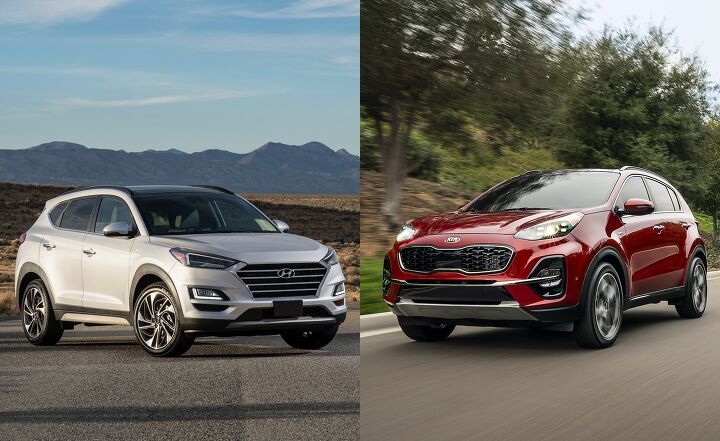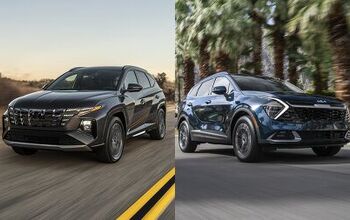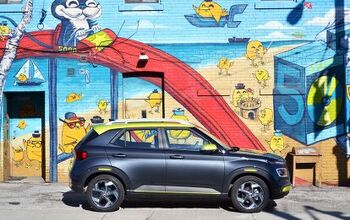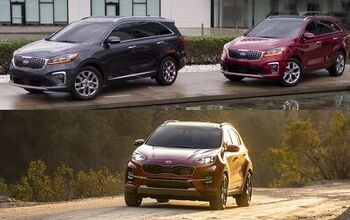Hyundai Tucson Vs Kia Sportage Comparison: Which One is Right for You?

The Hyundai Tucson and Kia Sportage are two popular choices in the compact crossover segment, and for good reason: they share a lot in common.
Hyundai and Kia both own portions of each other, and it’s lead to the two working together on much of their lineups. The Tucson and Sportage are one such example: both ride on the same platform, and offer buyers a lot of similar features.
Get a Quote on a New Hyundai Tucson or Kia SportgeThese two family haulers aren’t the same though. While both compete in the same segment, it’s a big one, allowing both Kia and Hyundai to target slightly different sections. That doesn’t stop many from cross-shopping the two, however.
Here we’ll cover the key differences between both the Hyundai Tucson and the Kia Sportage, to help you determine which is the best for your needs should you be in the market for one.
Body Styles/Design
{"attachment_id":"809424"}
Hyundai Tucson: Hyundai updated the Tucson late in 2018 for the 2019 model year. It was relatively minor facelift, mostly focusing on the grille and bumpers. The general look of the Tucson remains: it’s not the most dramatic option on the market, but that’s a benefit in this conservative segment. Hyundai got the general ingredients and proportions right, while available LED daytime running lights and larger alloy wheels help boost curb appeal. That, and the available bright blue paint.
Kia Sportage: Kia treated the Sportage to a facelift for this model year. Like the Tucson, it’s a light one, avoiding any major changes. That may or may not be your cup of tea: the Sportage’s “Tiger Nose” grille and high-set headlights are an acquired taste. Pair all that with the ice-cube tray foglights and you’ve got something that certainly stands apart from the rest of the pack.
Bottom Line: Despite sharing the same platform—and thus, dimensions—the Sportage and Tucson deliver two very different looks. Which you choose is really a matter of preference: the handsome if safe Hyundai, or the daring and dramatic Kia.
Space/Practicality
Hyundai Tucson: The Tucson is a compact two-row crossover with seating for five. It has a total interior volume of 133 cu-ft. A full 31 cu-ft of that is behind the rear seats, which grows to 61.9 cu-ft when you fold them down. Hyundai also claims front headroom of 39.6 inches and front leg room of 41.5 inches, while rear headroom sits at 39.2 inches and rear legroom at 38.2 inches.
Kia Sportage: The Sportage also features two rows of seating with—you guessed it—room for five. It has a total interior volume of 129.3 cu-ft and a cargo volume of 30.7 cu-ft with the second row up, and 60.1 cu-ft with the second row folded down. Kia claims front headroom of 39.3 inches and second-row headroom of 39.1 inches. Front legroom comes in at 41.5 inches and middle legroom is 38.2 inches.
ALSO SEE: Jeep Renegade vs Compass: Which Jeep is Right for You?
Bottom Line: Unsurprisingly, the Sportage and Tucson have almost identical interior space and cargo capacity. The Tucson just edges out its Kia sibling: those rakish looks will cost you, if only a tiny bit. No matter which you’re leaning towards, we recommend checking them out in person to get a better idea of the space available. Bring big items, like hockey bags or strollers, to make sure they fit.
Powertrains/Fuel Economy
Hyundai Tucson: The Hyundai Tucson is offered with two engines: a 161 hp 2.0-liter four-cylinder or a 181 hp 2.4-liter four-cylinder. Both engines are paired with a standard six-speed automatic transmission and all-wheel drive is available as an option.
The 2.0-liter front-wheel-drive models get 23 mpg city and 28 mpg highway for a combined rating of 25 mpg, while 2.0-liter AWD models get 22/25/23, respectively. The 2.4-liter front-drive models get 22 mpg city and 28 mpg highway for a combined rating of 25 mpg, while 2.4-liter AWD models score 21/26/23. Yes, the bigger engine is slightly more economical on the highway.
Kia Sportage: The Sportage is available with either an 185 hp version of the 2.4-liter four-cylinder engine, or a 240 hp 2.0-liter turbo. Like the Tucson, it sticks to a six-speed automatic transmission across both engine options, with either front- or all-wheel drive.
The 2.4-liter front-drive models get 23 mpg city and 30 mpg highway for a combined rating of 26 mpg. Those figures fall to 22/26/23 mpg for 2.4-liter AWD models.
Sportage 2.0-liter turbos with front-wheel drive are rated at 20 mpg city and 28 mpg highway for a combined effort of 23 mpg. Adding AWD will see those numbers drop to 19 mpg city, 24 mpg highway and 21 mpg combined.
Bottom Line: Both crossovers use the 2.4-liter engine, and that’d be our ideal choice. The Sportage offers it as standard though, whereas you’ll need to move up to a mid-trim Tucson to gain access there. We’d recommend that, especially with the negligible fuel efficiency difference.
If you want a genuinely quick crossover though, there’s only one option here: the turbocharged 2.0-liter in the Sportage. 240 hp is serious firepower in this class.
With the stronger engine lineup, we’re calling this a win for the Kia.
Driving Dynamics
Hyundai Tucson: We drove the Hyundai Tucson back in 2017 when it had a different powertrain consisting of a 1.6-liter turbo and a seven-speed DCT transmission. The DCT is no longer offered, which is a good thing because we had experienced some juddering and unrefined shifts from that transmission.
SEE ALSO: 2017 Honda CR-V vs Hyundai Tucson Comparison
The chassis hasn’t changed much since then, however, and we said that it was “comfortable, predictable, and rides smoothly over rough roads while still not feeling terrible in corners.” We also said the crossover felt “a lot more buttoned-down and composed than the (Honda) CR-V, which can feel sloppy at times.”
Kia Sportage: We drove the Sportage with the 2.4-liter four-cylinder engine and said the “engine power is plentiful and rightfully feels more stout than most of the Sportage’s competitors,” although we noted that it wasn’t as peppy as some turbocharged rivals at the time. We also said the crossover “drives smoothly with well controlled rebound over bumps while not jostling passengers. And the cabin remains fairly quiet, even on grooved concrete.”
Bottom Line: These crossovers ride on the same vehicle platforms and are nearly identical in size. It’s not surprising that they drive quite similarly, finding a middle ground between cornering composure and outright comfort.
Technology
Hyundai Tucson: The Tucson offers a 7.0-inch color touchscreen display as standard, which comes with Apple CarPlay and Android Auto, along with a six-speaker audio system. The crossover also comes with standard safety features like forward collision-avoidance assist, driver attention warning, lane keep assist, and more.
Blind spot monitoring, adaptive cruise control with stop-and-go, surround view monitor, rear-cross traffic alert, forward collision avoidance assist with pedestrian detection, high beam assist, a hands-free liftgate, ventilated front seats, and heated rear seats, an 8.0-inch touchscreen, wireless phone charging, rain sensing wipers, and second-row USB ports are also available.
ALSO SEE: Where is Hyundai From and Where are Hyundais Made?
Kia Sportage: The Sportage got a much-needed interior refresh for 2020, improving the standard tech across the range. An 8.0-inch touchscreen is the biggest change, available on all Sportages and continuing to support both Apple CarPlay and Android Auto. Auto emergency braking and warning, lane keep/departure warning, driver attention warning and auto headlights are all standard too.
Other available tech includes blind-spot detection, rear cross-traffic alert, dual front powered seats, a wireless phone charger and Harman Kardon audio system. Kia’s UVO system also allows owners to remote start their Sportage via smartphone.
Bottom Line: This used to be the Tucson’s decisive victory, but the 2020 Sportage update has brought it in line with its sibling. The available tech higher up the range is pretty much the same for both too. We’ll call it a wash, unless the additional inch of touchscreen real estate in the base Sportage is a dealmaker for you. Though the Tucson does start at slightly less. Speaking of pricing…
Pricing
Hyundai Tucson: The Tucson starts at $24,670 for the base model (including $1,120 in destination). The 2.4-liter FWD starts at $25,600, while the vehicle’s pricing tops out at $34,420 for the Tucson Ultimate with the 2.4-liter and AWD. The cheapest AWD model, the Tucson SE with the 2.0-liter engine, starts at $26,070.
Kia Sportage: The Sportage starts at $25,110 in the United States for the base model (also including $1,120 in destination). The 2.0-liter Turbo FWD starts at $34,710, while the vehicle tops out at $36,210 for the Sportage SX Turbo with AWD. The cheapest AWD model, the Sportage LX AWD, starts at $26,610.
Bottom Line: The Tucson is a bit more affordable than the Sportage, especially when both crossovers are in higher trim levels, although both are good value for money, in our opinion. The best value proposition here is the 2.4-liter Tucson SEL with AWD: it’s the best compromise between price and spec, and undercuts a similarly-equipped Sportage.
The Verdict: Hyundai Tucson vs Kia Sportage
Hyundai and Kia are both brands that are known for their good value. Both the Tucson and the Sportage are solid competitors in the compact crossover segment, and while some other crossovers may offer superior driving dynamics, these two are great value for money and should also be fairly reliable, too.
If your priorities are sensibility and ease-of-use, the Tucson clinches it. It’s the more buttoned-up option, and very slightly the value-oriented one too. If power is what you crave, only the Sportage will satisfy with its 2.0-liter turbo engine. Luckily the 2020 refresh has brought its interior experience up a step, eliminating its previous weakness against its platform mate.

Sam McEachern holds a diploma in journalism from St. Clair College in Windsor, Ontario, and has been covering the automotive industry for over 5 years. He conducts reviews and writes AutoGuide's news content. He's a die-hard motorsports fan with a passion for performance cars of all sorts.
More by Sam McEachern










































Comments
Join the conversation